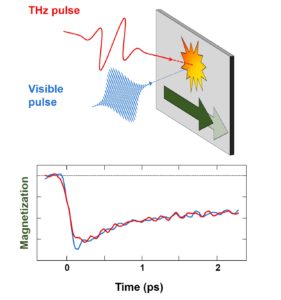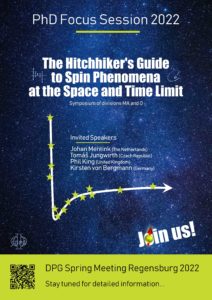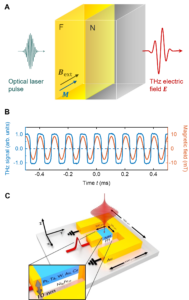News
Two TRR227 PhD students receive awards for “Best Contributed Talk” and “Best Poster” at the WE-Heraeus seminar
Jan 2022

Lisa-Marie Kern (Max Born Institute Berlin, division B2 “Imaging and Coherent X-rays”) and Oliver Gueckstock (FU Berlin, Terahertz Physics group), both PhD students of the TRR227, were awarded prizes for their contributions at the 757th Wilhelm-und-Else-Heraeus seminar on “Non-Linear Magnetism” from Jan 5-7, 2022. The seminar was held in a hybrid format having 40 on-site participants at the Physikzentrum in Bad Honnef and 60 online attendees, focusing on scientific exchange on non-linear magnetism [more...]
The heat of the moment in ultrafast magnetization quenching
Dec 2021

Researchers of the Collaborative Research Center TRR227 “Ultrafast spin dynamics” at Freie Universität Berlin found that the magnetization of laser-excited ferromagnetic iron undergoes the same dynamics independent of the wavelength of the driving laser pulse. Therefore, it is just the amount of heat dumped into the electrons at a given moment that determines the course of the demagnetization.
When a ferromagnet such as iron is heated, its magnetization decreases because the ordered electron spins (which can be thought of as little compass needles) are forced to fluctuate more strongly. Heating of the magnet can be done extremely fast by a femtosecond laser pulse. Iron and nickel are known to decrease their magnetization in a time as short as 100 fs. This ultrafast demagnetization provides fundamental insights into the coupling of electrons with their ordered spins.
“It is important to realize that the laser [more...]
When a ferromagnet such as iron is heated, its magnetization decreases because the ordered electron spins (which can be thought of as little compass needles) are forced to fluctuate more strongly. Heating of the magnet can be done extremely fast by a femtosecond laser pulse. Iron and nickel are known to decrease their magnetization in a time as short as 100 fs. This ultrafast demagnetization provides fundamental insights into the coupling of electrons with their ordered spins.
“It is important to realize that the laser [more...]
DPG PhD Focus Session 2022: “The Hitchhiker’s Guide to Spin Phenomena at the Space and Time Limit”
Dec 2021

The upcoming PhD focus session at the DPG Spring Meeting in Regensburg 2022 is jointly organized by young scientists from the SFB/TRR173 Kaiserslautern/Mainz and the SFB/TRR227 from Berlin/Halle.
The growing hunger of society for fast data storage and processing, together with the end of Moore’s law, demand the development of new technologies to implement smaller, faster and more power-efficient devices. Research in magnetic materials has shown the potential of spin-based devices in this regard. Pushing for “More than Moore” devices, space and time limits need to be tackled. At the heart of this research are three fundamental operations: Control of magnetic order, spin transport and efficient monitoring of spin angular momentum in space and time. Topical clusters ranging from ferro- to antiferromagnets up to 2D materials, magnetic-organic interfaces and heterostructures are extensively studied. New materials [more...]
The growing hunger of society for fast data storage and processing, together with the end of Moore’s law, demand the development of new technologies to implement smaller, faster and more power-efficient devices. Research in magnetic materials has shown the potential of spin-based devices in this regard. Pushing for “More than Moore” devices, space and time limits need to be tackled. At the heart of this research are three fundamental operations: Control of magnetic order, spin transport and efficient monitoring of spin angular momentum in space and time. Topical clusters ranging from ferro- to antiferromagnets up to 2D materials, magnetic-organic interfaces and heterostructures are extensively studied. New materials [more...]
INNOMAG Dissertation Prize 2020 for Dr. A. Johansson (MLU Halle) and Dr. T. S. Seifert (FU Berlin)
Oct 2021
Two PhD students/researchers of the TRR227 share the prestigious INNOMAG e.V. Dissertation Prize 2020 of the Magnetism Division of the Germany Physical Society: Dr. Annika Johansson (MLU Halle, group Quantum Theory of the Solid State) and Dr. Tom Sebastian Seifert (FU Berlin, THz Physics group).
Both awardees underwent a competitive preselection procedure and could successfully compete during the finalists’ session. Dr. Annika Johansson presented her results related to the calculation of spin to charge conversion mechanisms like the Rashba-Edelstein effect in [more...]
Both awardees underwent a competitive preselection procedure and could successfully compete during the finalists’ session. Dr. Annika Johansson presented her results related to the calculation of spin to charge conversion mechanisms like the Rashba-Edelstein effect in [more...]
New functionalities of spintronic terahertz emitters: rapid polarization control and on-chip integration
Aug 2021

Spintronic terahertz (THz) emitters (STEs) are a novel class of broadband, low-cost and efficient THz sources. They exhibit interesting opportunities for applications in the fields of THz physics and THz photonics, where THz electromagnetic pulses are used for material characterization, imaging and spectroscopy. Consequently, STEs are meanwhile commercially available from the Berlin-based startup TeraSpinTec GmbH.
To trigger the emission of ultrashort THz electromagnetic pulses, an STE is driven by femtosecond laser pulses (Figure A). STEs have unique properties: First, the polarization (i.e. the alignment) of the THz electric fieldis always perpendicular to the magnetization M of the STE, which, in turn, is straightforwardly controlled by the external magnetic field Bext. Second, because they are made of extremely thin metal layers, STEs can easily be shaped for integration [more...]
To trigger the emission of ultrashort THz electromagnetic pulses, an STE is driven by femtosecond laser pulses (Figure A). STEs have unique properties: First, the polarization (i.e. the alignment) of the THz electric fieldis always perpendicular to the magnetization M of the STE, which, in turn, is straightforwardly controlled by the external magnetic field Bext. Second, because they are made of extremely thin metal layers, STEs can easily be shaped for integration [more...]